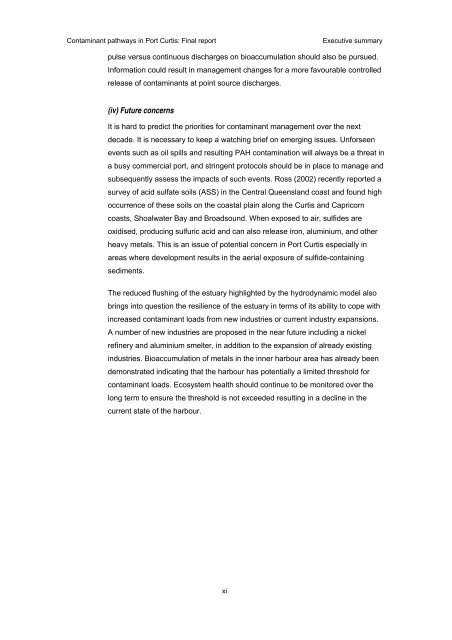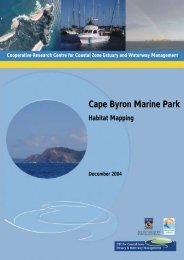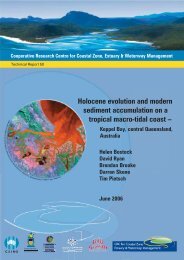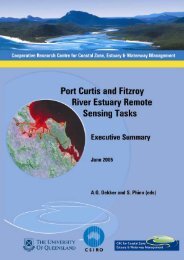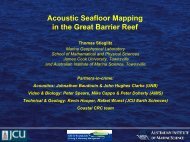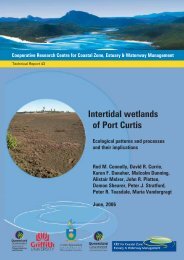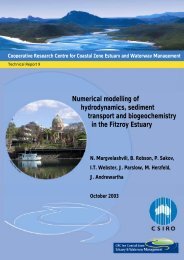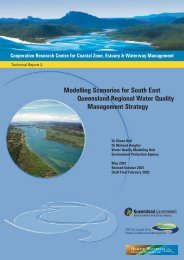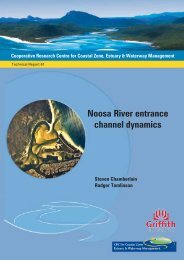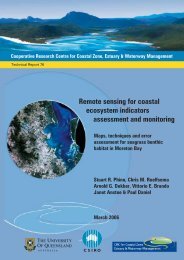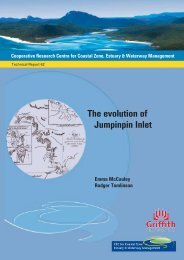Contaminant pathways in Port Curtis: Final report - OzCoasts
Contaminant pathways in Port Curtis: Final report - OzCoasts
Contaminant pathways in Port Curtis: Final report - OzCoasts
You also want an ePaper? Increase the reach of your titles
YUMPU automatically turns print PDFs into web optimized ePapers that Google loves.
<strong>Contam<strong>in</strong>ant</strong> <strong>pathways</strong> <strong>in</strong> <strong>Port</strong> <strong>Curtis</strong>: F<strong>in</strong>al <strong>report</strong>Executive summarypulse versus cont<strong>in</strong>uous discharges on bioaccumulation should also be pursued.Information could result <strong>in</strong> management changes for a more favourable controlledrelease of contam<strong>in</strong>ants at po<strong>in</strong>t source discharges.(iv) Future concernsIt is hard to predict the priorities for contam<strong>in</strong>ant management over the nextdecade. It is necessary to keep a watch<strong>in</strong>g brief on emerg<strong>in</strong>g issues. Unforseenevents such as oil spills and result<strong>in</strong>g PAH contam<strong>in</strong>ation will always be a threat <strong>in</strong>a busy commercial port, and str<strong>in</strong>gent protocols should be <strong>in</strong> place to manage andsubsequently assess the impacts of such events. Ross (2002) recently <strong>report</strong>ed asurvey of acid sulfate soils (ASS) <strong>in</strong> the Central Queensland coast and found highoccurrence of these soils on the coastal pla<strong>in</strong> along the <strong>Curtis</strong> and Capricorncoasts, Shoalwater Bay and Broadsound. When exposed to air, sulfides areoxidised, produc<strong>in</strong>g sulfuric acid and can also release iron, alum<strong>in</strong>ium, and otherheavy metals. This is an issue of potential concern <strong>in</strong> <strong>Port</strong> <strong>Curtis</strong> especially <strong>in</strong>areas where development results <strong>in</strong> the aerial exposure of sulfide-conta<strong>in</strong><strong>in</strong>gsediments.The reduced flush<strong>in</strong>g of the estuary highlighted by the hydrodynamic model alsobr<strong>in</strong>gs <strong>in</strong>to question the resilience of the estuary <strong>in</strong> terms of its ability to cope with<strong>in</strong>creased contam<strong>in</strong>ant loads from new <strong>in</strong>dustries or current <strong>in</strong>dustry expansions.A number of new <strong>in</strong>dustries are proposed <strong>in</strong> the near future <strong>in</strong>clud<strong>in</strong>g a nickelref<strong>in</strong>ery and alum<strong>in</strong>ium smelter, <strong>in</strong> addition to the expansion of already exist<strong>in</strong>g<strong>in</strong>dustries. Bioaccumulation of metals <strong>in</strong> the <strong>in</strong>ner harbour area has already beendemonstrated <strong>in</strong>dicat<strong>in</strong>g that the harbour has potentially a limited threshold forcontam<strong>in</strong>ant loads. Ecosystem health should cont<strong>in</strong>ue to be monitored over thelong term to ensure the threshold is not exceeded result<strong>in</strong>g <strong>in</strong> a decl<strong>in</strong>e <strong>in</strong> thecurrent state of the harbour.xi


